Water Pollution in India: Challenges and Mitigation Strategies
VerifiedAdded on 2022/10/19
|7
|1532
|339
Report
AI Summary
This report provides a comprehensive overview of water pollution in India, focusing on the sources, impacts, and potential solutions to this critical environmental issue. The report highlights the significant pollution from untreated sewage, industrial waste, and agricultural runoff, particularly in South India. It examines the current state of water treatment facilities, the challenges faced, and the disparity between sewage production and treatment capacity. The report also discusses the effects of pollution on water bodies, including rivers and underground water sources, and the resulting health implications. Furthermore, the report explores potential solutions, such as natural sewage treatment methods involving vegetation, and the importance of mass education and policy implementation. The report concludes by emphasizing the need for effective water conservation strategies, including stricter regulations and the adoption of sustainable practices to mitigate the adverse effects of water pollution and ensure the availability of clean water for all.
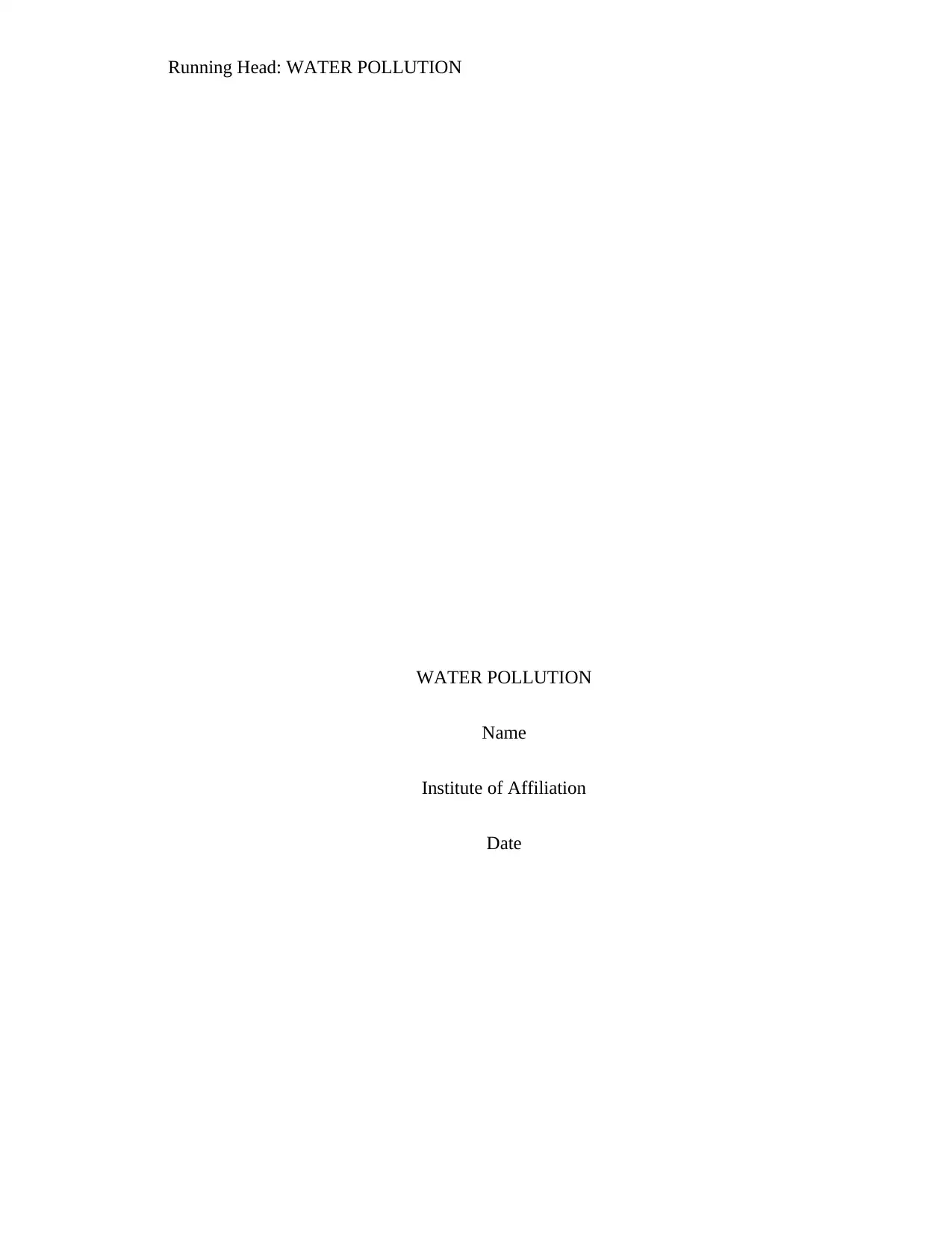
Running Head: WATER POLLUTION
WATER POLLUTION
Name
Institute of Affiliation
Date
WATER POLLUTION
Name
Institute of Affiliation
Date
Paraphrase This Document
Need a fresh take? Get an instant paraphrase of this document with our AI Paraphraser
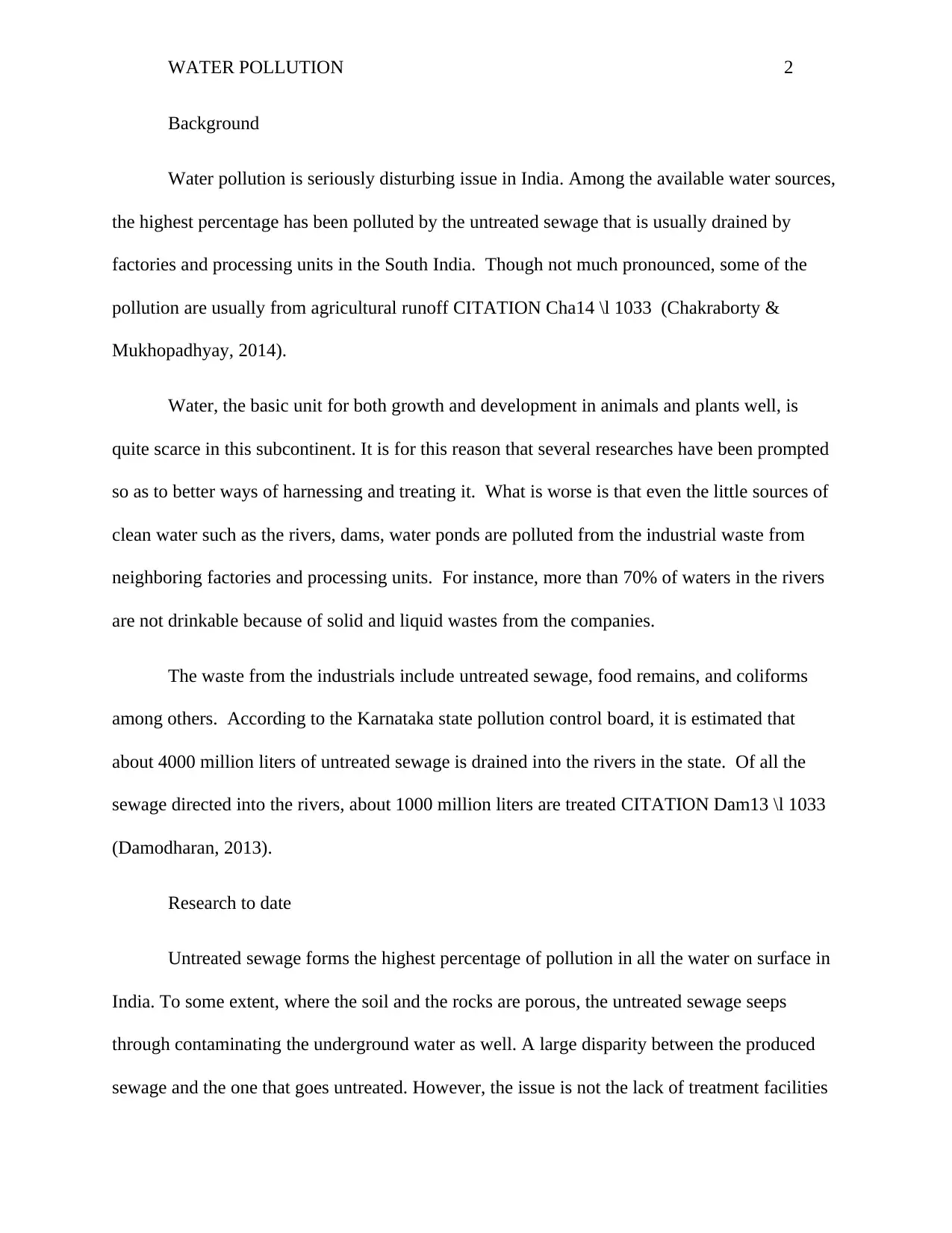
WATER POLLUTION 2
Background
Water pollution is seriously disturbing issue in India. Among the available water sources,
the highest percentage has been polluted by the untreated sewage that is usually drained by
factories and processing units in the South India. Though not much pronounced, some of the
pollution are usually from agricultural runoff CITATION Cha14 \l 1033 (Chakraborty &
Mukhopadhyay, 2014).
Water, the basic unit for both growth and development in animals and plants well, is
quite scarce in this subcontinent. It is for this reason that several researches have been prompted
so as to better ways of harnessing and treating it. What is worse is that even the little sources of
clean water such as the rivers, dams, water ponds are polluted from the industrial waste from
neighboring factories and processing units. For instance, more than 70% of waters in the rivers
are not drinkable because of solid and liquid wastes from the companies.
The waste from the industrials include untreated sewage, food remains, and coliforms
among others. According to the Karnataka state pollution control board, it is estimated that
about 4000 million liters of untreated sewage is drained into the rivers in the state. Of all the
sewage directed into the rivers, about 1000 million liters are treated CITATION Dam13 \l 1033
(Damodharan, 2013).
Research to date
Untreated sewage forms the highest percentage of pollution in all the water on surface in
India. To some extent, where the soil and the rocks are porous, the untreated sewage seeps
through contaminating the underground water as well. A large disparity between the produced
sewage and the one that goes untreated. However, the issue is not the lack of treatment facilities
Background
Water pollution is seriously disturbing issue in India. Among the available water sources,
the highest percentage has been polluted by the untreated sewage that is usually drained by
factories and processing units in the South India. Though not much pronounced, some of the
pollution are usually from agricultural runoff CITATION Cha14 \l 1033 (Chakraborty &
Mukhopadhyay, 2014).
Water, the basic unit for both growth and development in animals and plants well, is
quite scarce in this subcontinent. It is for this reason that several researches have been prompted
so as to better ways of harnessing and treating it. What is worse is that even the little sources of
clean water such as the rivers, dams, water ponds are polluted from the industrial waste from
neighboring factories and processing units. For instance, more than 70% of waters in the rivers
are not drinkable because of solid and liquid wastes from the companies.
The waste from the industrials include untreated sewage, food remains, and coliforms
among others. According to the Karnataka state pollution control board, it is estimated that
about 4000 million liters of untreated sewage is drained into the rivers in the state. Of all the
sewage directed into the rivers, about 1000 million liters are treated CITATION Dam13 \l 1033
(Damodharan, 2013).
Research to date
Untreated sewage forms the highest percentage of pollution in all the water on surface in
India. To some extent, where the soil and the rocks are porous, the untreated sewage seeps
through contaminating the underground water as well. A large disparity between the produced
sewage and the one that goes untreated. However, the issue is not the lack of treatment facilities
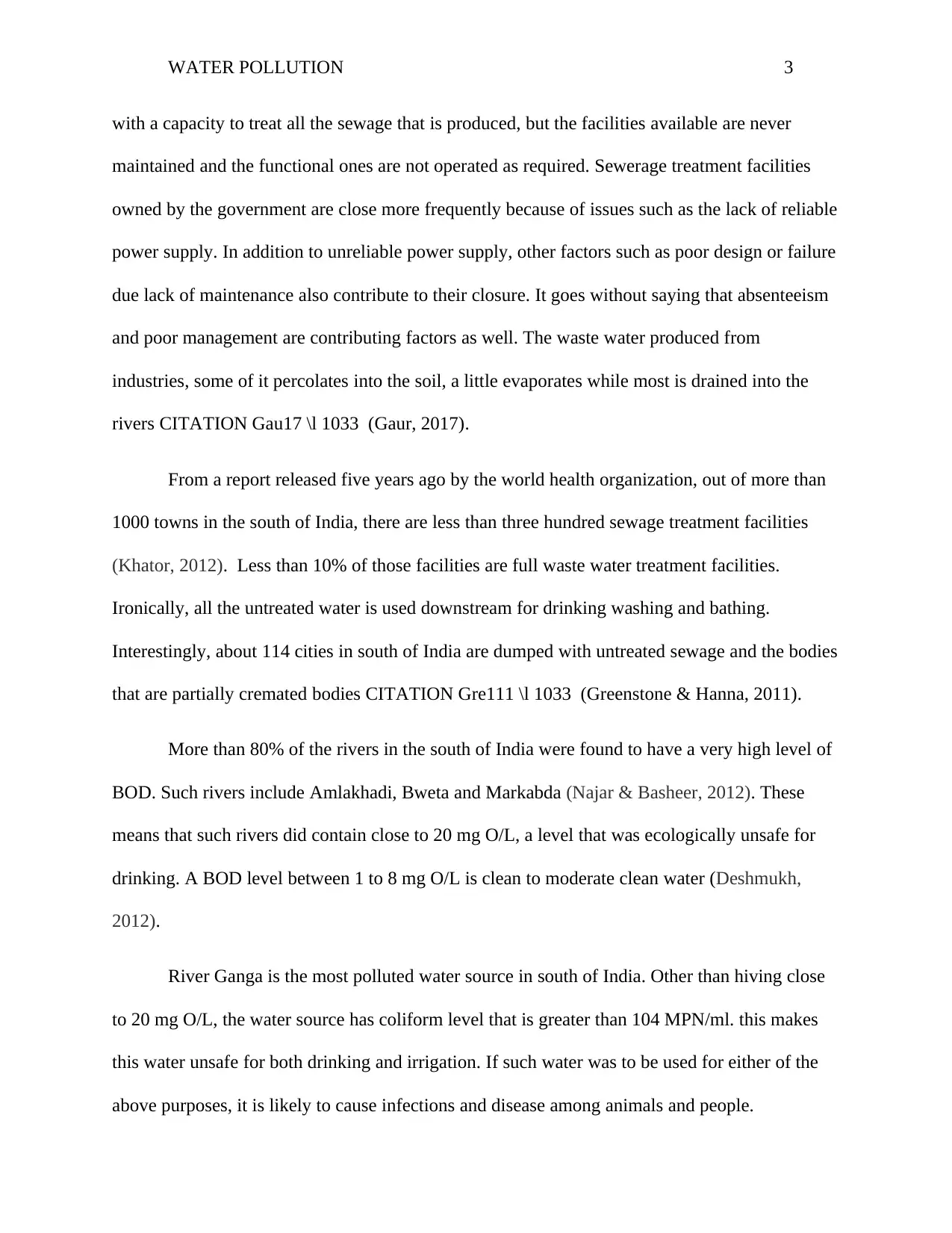
WATER POLLUTION 3
with a capacity to treat all the sewage that is produced, but the facilities available are never
maintained and the functional ones are not operated as required. Sewerage treatment facilities
owned by the government are close more frequently because of issues such as the lack of reliable
power supply. In addition to unreliable power supply, other factors such as poor design or failure
due lack of maintenance also contribute to their closure. It goes without saying that absenteeism
and poor management are contributing factors as well. The waste water produced from
industries, some of it percolates into the soil, a little evaporates while most is drained into the
rivers CITATION Gau17 \l 1033 (Gaur, 2017).
From a report released five years ago by the world health organization, out of more than
1000 towns in the south of India, there are less than three hundred sewage treatment facilities
(Khator, 2012). Less than 10% of those facilities are full waste water treatment facilities.
Ironically, all the untreated water is used downstream for drinking washing and bathing.
Interestingly, about 114 cities in south of India are dumped with untreated sewage and the bodies
that are partially cremated bodies CITATION Gre111 \l 1033 (Greenstone & Hanna, 2011).
More than 80% of the rivers in the south of India were found to have a very high level of
BOD. Such rivers include Amlakhadi, Bweta and Markabda (Najar & Basheer, 2012). These
means that such rivers did contain close to 20 mg O/L, a level that was ecologically unsafe for
drinking. A BOD level between 1 to 8 mg O/L is clean to moderate clean water (Deshmukh,
2012).
River Ganga is the most polluted water source in south of India. Other than hiving close
to 20 mg O/L, the water source has coliform level that is greater than 104 MPN/ml. this makes
this water unsafe for both drinking and irrigation. If such water was to be used for either of the
above purposes, it is likely to cause infections and disease among animals and people.
with a capacity to treat all the sewage that is produced, but the facilities available are never
maintained and the functional ones are not operated as required. Sewerage treatment facilities
owned by the government are close more frequently because of issues such as the lack of reliable
power supply. In addition to unreliable power supply, other factors such as poor design or failure
due lack of maintenance also contribute to their closure. It goes without saying that absenteeism
and poor management are contributing factors as well. The waste water produced from
industries, some of it percolates into the soil, a little evaporates while most is drained into the
rivers CITATION Gau17 \l 1033 (Gaur, 2017).
From a report released five years ago by the world health organization, out of more than
1000 towns in the south of India, there are less than three hundred sewage treatment facilities
(Khator, 2012). Less than 10% of those facilities are full waste water treatment facilities.
Ironically, all the untreated water is used downstream for drinking washing and bathing.
Interestingly, about 114 cities in south of India are dumped with untreated sewage and the bodies
that are partially cremated bodies CITATION Gre111 \l 1033 (Greenstone & Hanna, 2011).
More than 80% of the rivers in the south of India were found to have a very high level of
BOD. Such rivers include Amlakhadi, Bweta and Markabda (Najar & Basheer, 2012). These
means that such rivers did contain close to 20 mg O/L, a level that was ecologically unsafe for
drinking. A BOD level between 1 to 8 mg O/L is clean to moderate clean water (Deshmukh,
2012).
River Ganga is the most polluted water source in south of India. Other than hiving close
to 20 mg O/L, the water source has coliform level that is greater than 104 MPN/ml. this makes
this water unsafe for both drinking and irrigation. If such water was to be used for either of the
above purposes, it is likely to cause infections and disease among animals and people.
⊘ This is a preview!⊘
Do you want full access?
Subscribe today to unlock all pages.

Trusted by 1+ million students worldwide
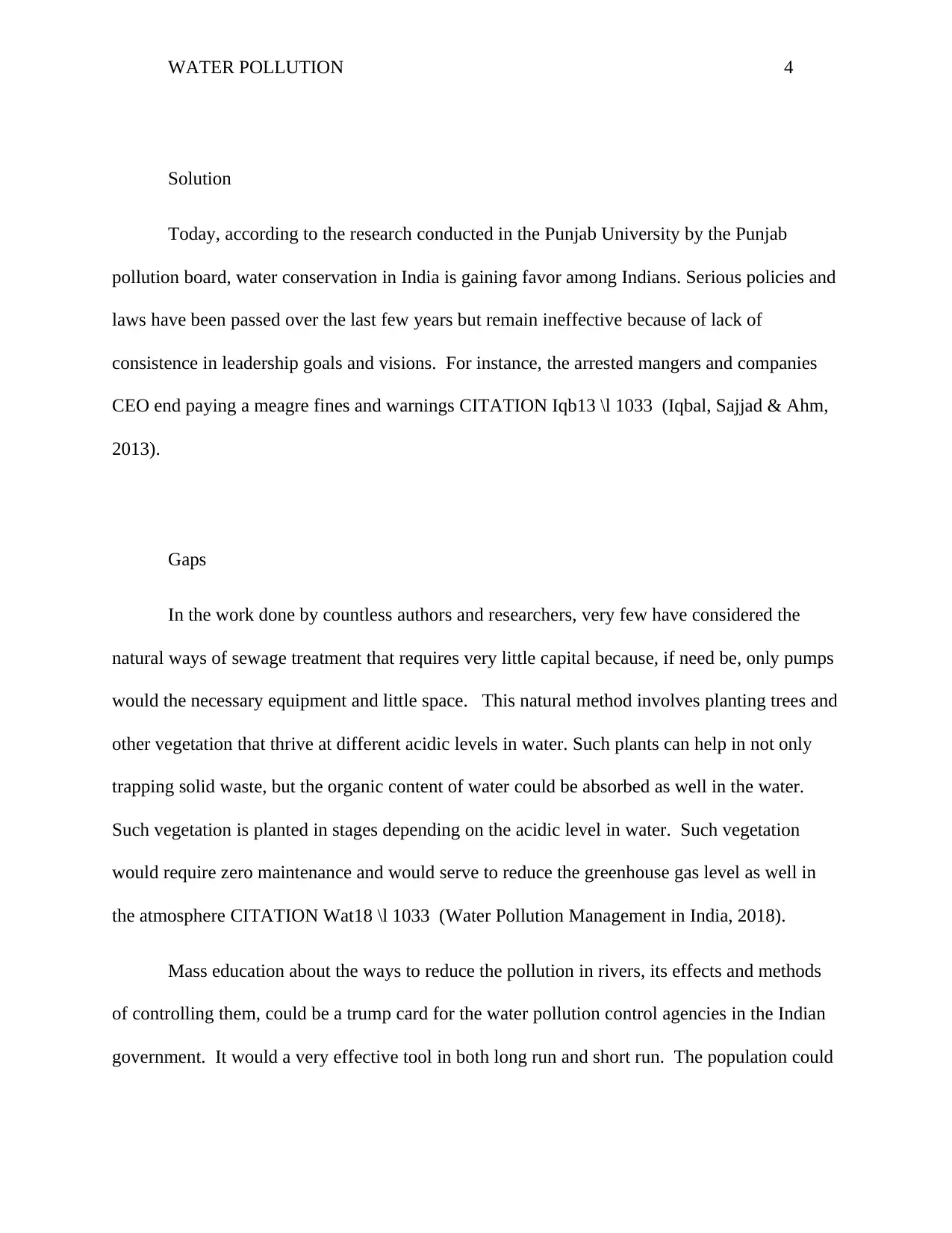
WATER POLLUTION 4
Solution
Today, according to the research conducted in the Punjab University by the Punjab
pollution board, water conservation in India is gaining favor among Indians. Serious policies and
laws have been passed over the last few years but remain ineffective because of lack of
consistence in leadership goals and visions. For instance, the arrested mangers and companies
CEO end paying a meagre fines and warnings CITATION Iqb13 \l 1033 (Iqbal, Sajjad & Ahm,
2013).
Gaps
In the work done by countless authors and researchers, very few have considered the
natural ways of sewage treatment that requires very little capital because, if need be, only pumps
would the necessary equipment and little space. This natural method involves planting trees and
other vegetation that thrive at different acidic levels in water. Such plants can help in not only
trapping solid waste, but the organic content of water could be absorbed as well in the water.
Such vegetation is planted in stages depending on the acidic level in water. Such vegetation
would require zero maintenance and would serve to reduce the greenhouse gas level as well in
the atmosphere CITATION Wat18 \l 1033 (Water Pollution Management in India, 2018).
Mass education about the ways to reduce the pollution in rivers, its effects and methods
of controlling them, could be a trump card for the water pollution control agencies in the Indian
government. It would a very effective tool in both long run and short run. The population could
Solution
Today, according to the research conducted in the Punjab University by the Punjab
pollution board, water conservation in India is gaining favor among Indians. Serious policies and
laws have been passed over the last few years but remain ineffective because of lack of
consistence in leadership goals and visions. For instance, the arrested mangers and companies
CEO end paying a meagre fines and warnings CITATION Iqb13 \l 1033 (Iqbal, Sajjad & Ahm,
2013).
Gaps
In the work done by countless authors and researchers, very few have considered the
natural ways of sewage treatment that requires very little capital because, if need be, only pumps
would the necessary equipment and little space. This natural method involves planting trees and
other vegetation that thrive at different acidic levels in water. Such plants can help in not only
trapping solid waste, but the organic content of water could be absorbed as well in the water.
Such vegetation is planted in stages depending on the acidic level in water. Such vegetation
would require zero maintenance and would serve to reduce the greenhouse gas level as well in
the atmosphere CITATION Wat18 \l 1033 (Water Pollution Management in India, 2018).
Mass education about the ways to reduce the pollution in rivers, its effects and methods
of controlling them, could be a trump card for the water pollution control agencies in the Indian
government. It would a very effective tool in both long run and short run. The population could
Paraphrase This Document
Need a fresh take? Get an instant paraphrase of this document with our AI Paraphraser
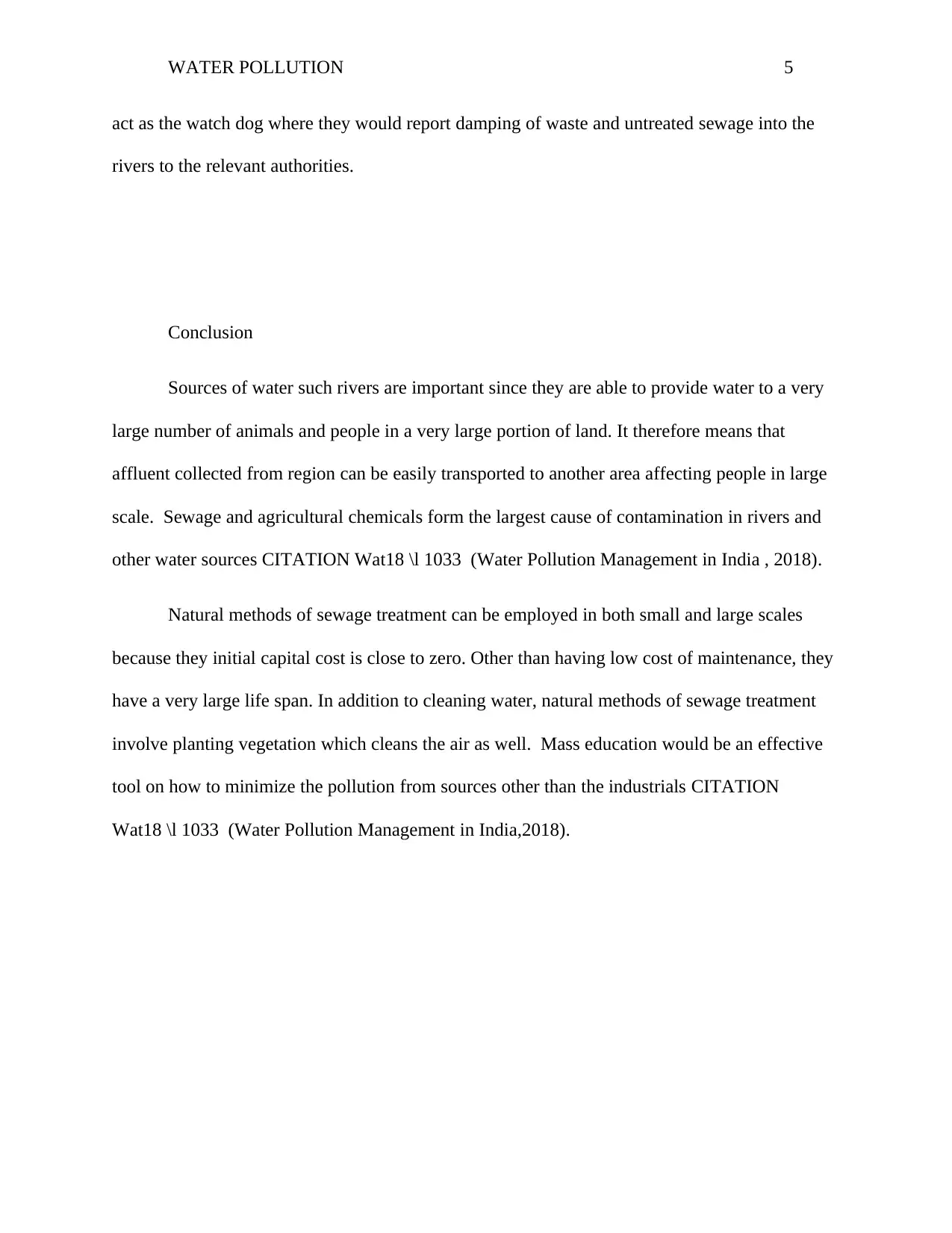
WATER POLLUTION 5
act as the watch dog where they would report damping of waste and untreated sewage into the
rivers to the relevant authorities.
Conclusion
Sources of water such rivers are important since they are able to provide water to a very
large number of animals and people in a very large portion of land. It therefore means that
affluent collected from region can be easily transported to another area affecting people in large
scale. Sewage and agricultural chemicals form the largest cause of contamination in rivers and
other water sources CITATION Wat18 \l 1033 (Water Pollution Management in India , 2018).
Natural methods of sewage treatment can be employed in both small and large scales
because they initial capital cost is close to zero. Other than having low cost of maintenance, they
have a very large life span. In addition to cleaning water, natural methods of sewage treatment
involve planting vegetation which cleans the air as well. Mass education would be an effective
tool on how to minimize the pollution from sources other than the industrials CITATION
Wat18 \l 1033 (Water Pollution Management in India,2018).
act as the watch dog where they would report damping of waste and untreated sewage into the
rivers to the relevant authorities.
Conclusion
Sources of water such rivers are important since they are able to provide water to a very
large number of animals and people in a very large portion of land. It therefore means that
affluent collected from region can be easily transported to another area affecting people in large
scale. Sewage and agricultural chemicals form the largest cause of contamination in rivers and
other water sources CITATION Wat18 \l 1033 (Water Pollution Management in India , 2018).
Natural methods of sewage treatment can be employed in both small and large scales
because they initial capital cost is close to zero. Other than having low cost of maintenance, they
have a very large life span. In addition to cleaning water, natural methods of sewage treatment
involve planting vegetation which cleans the air as well. Mass education would be an effective
tool on how to minimize the pollution from sources other than the industrials CITATION
Wat18 \l 1033 (Water Pollution Management in India,2018).
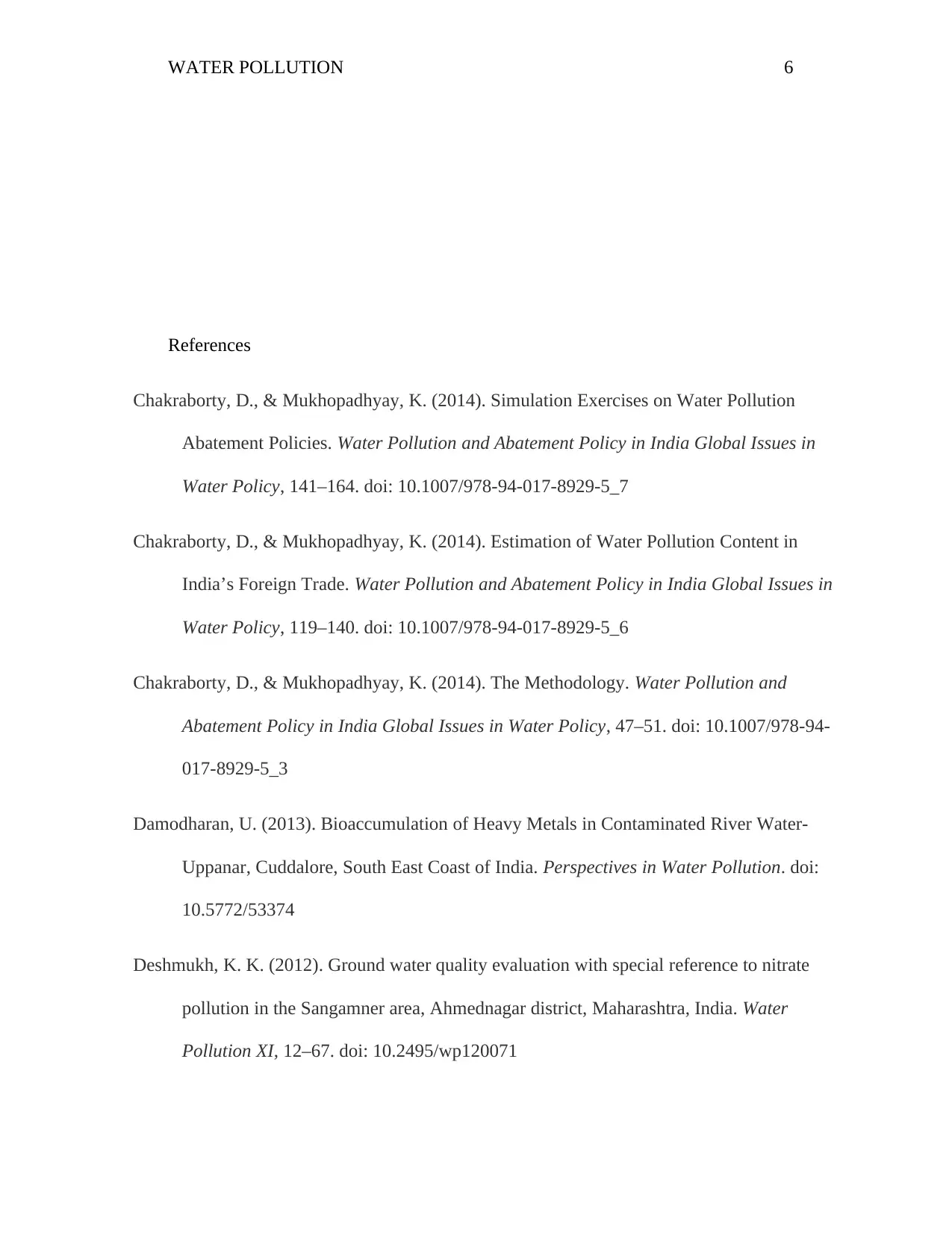
WATER POLLUTION 6
References
Chakraborty, D., & Mukhopadhyay, K. (2014). Simulation Exercises on Water Pollution
Abatement Policies. Water Pollution and Abatement Policy in India Global Issues in
Water Policy, 141–164. doi: 10.1007/978-94-017-8929-5_7
Chakraborty, D., & Mukhopadhyay, K. (2014). Estimation of Water Pollution Content in
India’s Foreign Trade. Water Pollution and Abatement Policy in India Global Issues in
Water Policy, 119–140. doi: 10.1007/978-94-017-8929-5_6
Chakraborty, D., & Mukhopadhyay, K. (2014). The Methodology. Water Pollution and
Abatement Policy in India Global Issues in Water Policy, 47–51. doi: 10.1007/978-94-
017-8929-5_3
Damodharan, U. (2013). Bioaccumulation of Heavy Metals in Contaminated River Water-
Uppanar, Cuddalore, South East Coast of India. Perspectives in Water Pollution. doi:
10.5772/53374
Deshmukh, K. K. (2012). Ground water quality evaluation with special reference to nitrate
pollution in the Sangamner area, Ahmednagar district, Maharashtra, India. Water
Pollution XI, 12–67. doi: 10.2495/wp120071
References
Chakraborty, D., & Mukhopadhyay, K. (2014). Simulation Exercises on Water Pollution
Abatement Policies. Water Pollution and Abatement Policy in India Global Issues in
Water Policy, 141–164. doi: 10.1007/978-94-017-8929-5_7
Chakraborty, D., & Mukhopadhyay, K. (2014). Estimation of Water Pollution Content in
India’s Foreign Trade. Water Pollution and Abatement Policy in India Global Issues in
Water Policy, 119–140. doi: 10.1007/978-94-017-8929-5_6
Chakraborty, D., & Mukhopadhyay, K. (2014). The Methodology. Water Pollution and
Abatement Policy in India Global Issues in Water Policy, 47–51. doi: 10.1007/978-94-
017-8929-5_3
Damodharan, U. (2013). Bioaccumulation of Heavy Metals in Contaminated River Water-
Uppanar, Cuddalore, South East Coast of India. Perspectives in Water Pollution. doi:
10.5772/53374
Deshmukh, K. K. (2012). Ground water quality evaluation with special reference to nitrate
pollution in the Sangamner area, Ahmednagar district, Maharashtra, India. Water
Pollution XI, 12–67. doi: 10.2495/wp120071
⊘ This is a preview!⊘
Do you want full access?
Subscribe today to unlock all pages.

Trusted by 1+ million students worldwide
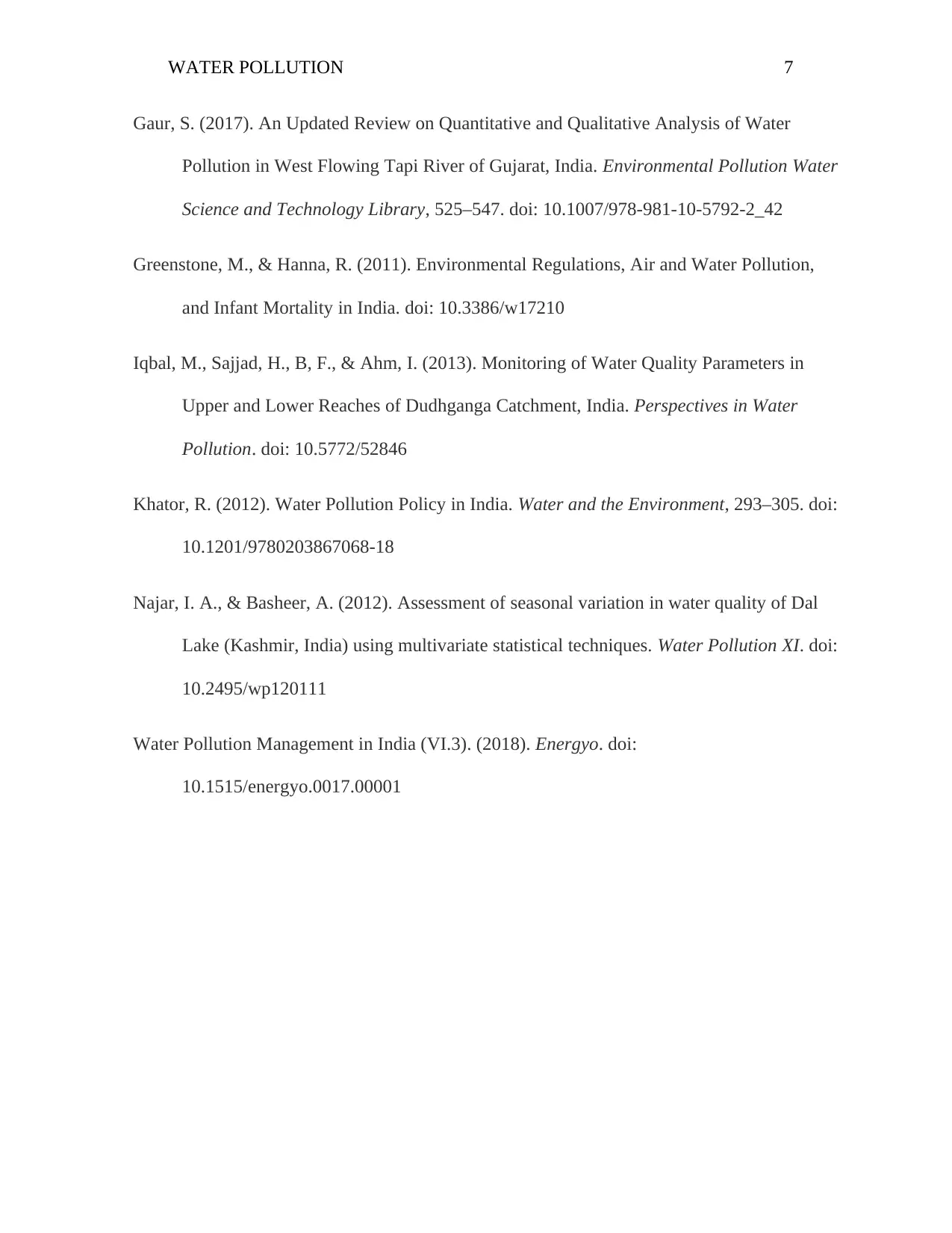
WATER POLLUTION 7
Gaur, S. (2017). An Updated Review on Quantitative and Qualitative Analysis of Water
Pollution in West Flowing Tapi River of Gujarat, India. Environmental Pollution Water
Science and Technology Library, 525–547. doi: 10.1007/978-981-10-5792-2_42
Greenstone, M., & Hanna, R. (2011). Environmental Regulations, Air and Water Pollution,
and Infant Mortality in India. doi: 10.3386/w17210
Iqbal, M., Sajjad, H., B, F., & Ahm, I. (2013). Monitoring of Water Quality Parameters in
Upper and Lower Reaches of Dudhganga Catchment, India. Perspectives in Water
Pollution. doi: 10.5772/52846
Khator, R. (2012). Water Pollution Policy in India. Water and the Environment, 293–305. doi:
10.1201/9780203867068-18
Najar, I. A., & Basheer, A. (2012). Assessment of seasonal variation in water quality of Dal
Lake (Kashmir, India) using multivariate statistical techniques. Water Pollution XI. doi:
10.2495/wp120111
Water Pollution Management in India (VI.3). (2018). Energyo. doi:
10.1515/energyo.0017.00001
Gaur, S. (2017). An Updated Review on Quantitative and Qualitative Analysis of Water
Pollution in West Flowing Tapi River of Gujarat, India. Environmental Pollution Water
Science and Technology Library, 525–547. doi: 10.1007/978-981-10-5792-2_42
Greenstone, M., & Hanna, R. (2011). Environmental Regulations, Air and Water Pollution,
and Infant Mortality in India. doi: 10.3386/w17210
Iqbal, M., Sajjad, H., B, F., & Ahm, I. (2013). Monitoring of Water Quality Parameters in
Upper and Lower Reaches of Dudhganga Catchment, India. Perspectives in Water
Pollution. doi: 10.5772/52846
Khator, R. (2012). Water Pollution Policy in India. Water and the Environment, 293–305. doi:
10.1201/9780203867068-18
Najar, I. A., & Basheer, A. (2012). Assessment of seasonal variation in water quality of Dal
Lake (Kashmir, India) using multivariate statistical techniques. Water Pollution XI. doi:
10.2495/wp120111
Water Pollution Management in India (VI.3). (2018). Energyo. doi:
10.1515/energyo.0017.00001
1 out of 7
Your All-in-One AI-Powered Toolkit for Academic Success.
+13062052269
info@desklib.com
Available 24*7 on WhatsApp / Email
![[object Object]](/_next/static/media/star-bottom.7253800d.svg)
Unlock your academic potential
Copyright © 2020–2025 A2Z Services. All Rights Reserved. Developed and managed by ZUCOL.


